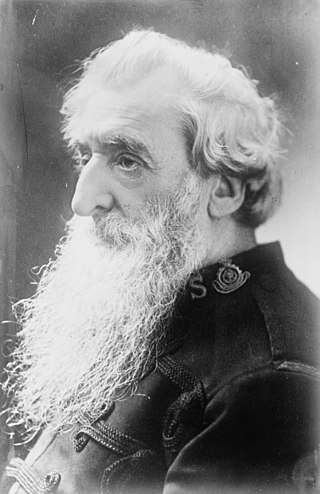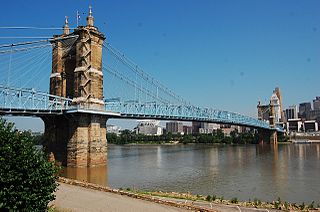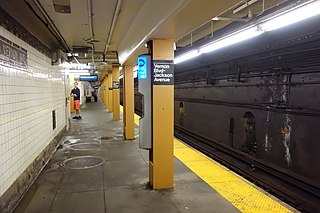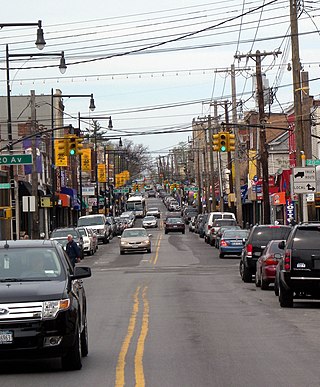
William Booth was an English Methodist preacher who, along with his wife, Catherine, founded the Salvation Army and became its first General (1878–1912). The Christian movement with a quasi-military structure and government founded in 1865 has spread from London to many parts of the world through British Imperialism and colonisation, it is known for being one of the largest distributors of humanitarian aid.

Flushing is a neighborhood in the north-central portion of the New York City borough of Queens. The neighborhood is the fourth-largest central business district in New York City. Downtown Flushing is a major commercial and retail area, and the intersection of Main Street and Roosevelt Avenue at its core is the third-busiest in New York City, behind Times Square and Herald Square.

The John A. Roebling Suspension Bridge is a suspension bridge that spans the Ohio River between Cincinnati, Ohio, and Covington, Kentucky. When opened on December 1, 1866, it was the longest suspension bridge in the world at 1,057 feet (322 m) main span, which was later overtaken by John A. Roebling's most famous design of the 1883 Brooklyn Bridge at 1,595.5 feet (486.3 m). Pedestrians use the bridge to get between the hotels, bars, restaurants, and parking lots in Northern Kentucky. The bar and restaurant district at the foot of the bridge on the Kentucky side is known as Roebling Point.

The Vernon Boulevard–Jackson Avenue station is a station on the IRT Flushing Line of the New York City Subway, and the westernmost station on the Flushing Line in Queens. It is served by the 7 train at all times and the <7> train rush hours in the peak direction. Despite its name, the station is not quite located at the intersection of Vernon Boulevard and Jackson Avenue. It is located on 50th Avenue between Vernon Boulevard and Jackson Avenue, both of which have entrances to the station.
The NewYork-Presbyterian Hospital is a nonprofit academic medical center in New York City affiliated with two Ivy League medical schools, Cornell University and Columbia University. The hospital comprises seven distinct campuses located in the New York metropolitan area. The hospital's two flagship medical centers are Columbia University Irving Medical Center and Weill Cornell Medical Center, situated on opposite sides of Upper Manhattan.

Queens Botanical Garden is a botanical garden located at 43-50 Main Street in Flushing, Queens, New York City. The 39-acre (16 ha) site features rose, bee, herb, wedding, and perennial gardens; an arboretum; an art gallery; and a LEED-certified Visitor & Administration Building. Queens Botanical Garden is located on property owned by the City of New York, and is funded from several public and private sources. It is operated by Queens Botanical Garden Society, Inc.

Kissena Park is a 235-acre (95 ha) park located in the neighborhood of Flushing in Queens, New York City. It is located along the subterranean Kissena Creek, which flows into the Flushing River. It is bordered on the west by Kissena Boulevard; on the north by Rose, Oak, Underhill, and Lithonia Avenues; on the east by Fresh Meadow Lane; and on the south by Booth Memorial Avenue. The park contains the city's only remaining velodrome, a lake of the same name, two war memorials, and various playgrounds and sports fields.

College Point is a working-middle-class neighborhood in the New York City borough of Queens. It is bounded to the south by Whitestone Expressway and Flushing; to the east by 138th Street and Malba/Whitestone; to the north by the East River; and to the west by Flushing Bay. College Point is a mostly residential ethnically diverse community with some industrial areas. The neighborhood is served by several parks and contains two yacht clubs.

The Jackson Heights–Roosevelt Avenue/74th Street station is a New York City Subway station complex served by the IRT Flushing Line and the IND Queens Boulevard Line. Located at the triangle of 74th Street, Broadway, and Roosevelt Avenue in Jackson Heights, Queens, it is served by the 7, E, and F trains at all times; the R train at all times except late nights; and the <F> train during rush hours in the reverse peak direction.

The Court Square–23rd Street station is a New York City Subway station complex on the IND Crosstown Line, the IRT Flushing Line and the IND Queens Boulevard Line. The complex is located in the vicinity of One Court Square in Hunters Point and Long Island City, Queens, and is served by the 7, E, F, and G trains at all times; the <7> express train during weekdays in the peak direction; and the <F> train during rush hours in the reverse-peak direction.
Booth Memorial Hospital of Cleveland was a short-term hospital in Cleveland, Ohio, United States. It was closed on November 30, 1991. At the time of closing, it had 54 beds and 132.75 full-time equivalent staff members.

The Daniel Carter Beard Boyhood Home is a National Historic Landmark located in the Riverside Drive Historic District of Covington, Kentucky, overlooking the Licking River, across the Ohio River from Cincinnati, Ohio. The two-and-one-half story brick domicile, built in 1821 and one of the two oldest buildings in Kenton County, Kentucky, is the boyhood home of Daniel Carter Beard, a founder of the Boy Scouts of America. He was their National Scout Commissioner from its 1910 founding to his death in 1941.
Frank D. O'Connor was an American lawyer and politician from New York.

Main Street is a major north–south street in the borough of Queens in New York City, extending from Queens Boulevard in Briarwood to Northern Boulevard in Flushing. Created in the 17th century as one of Flushing's main roads, Main Street has been lengthened at various points in its existence.

James Simpson Jr (1928–1999) was the first African American to win a city commission election in the history of Covington, Kentucky. Simpson was one of nearly 30 people who filed to run for the City Commission in 1971. He finished third, winning one of four seats and making political history. Simpson served the full two-year term. He later finished an un-expired term on the commission in 1991. Simpson was active in many other civic groups. He served on the following boards: Kenton County Airport Board, People's Liberty Bank Board of Directors, Booth Hospital in Covington, St. Elizabeth Hospital in Covington and the Kenton County TB Sanatorium. Simpson was also one of the founders of the Northern Kentucky Community Center in the Eastside Neighborhood of Covington. James Edward Simpson Jr is father to State Representative Arnold Ray Simpson who serves the 65th district of Kentucky, the first African American to hold this seat at the Kentucky State Assembly.

NewYork-Presbyterian Queens, stylized as NewYork-Presbyterian/Queens (NYP/Q or NYP/Queens), is a not-for-profit acute care and teaching hospital affiliated with Weill Cornell Medicine in the Flushing neighborhood of Queens in New York City. Formerly operating as Booth Memorial Hospital and New York Hospital Queens (NYHQ), it is located on the northeast corner of Main Street and Booth Memorial Avenue.

Louise Southgate was one of the first women physicians in Northern Kentucky where she advocated for girls in the juvenile court system and was an early proponent of birth control. Besides her medical practice and outreach, she led many efforts for the American women's suffrage movement through her local clubs and the Kentucky Equal Rights Association.

The Salvation Army Headquarters is a building at 120–130 14th Street in the Chelsea and Greenwich Village neighborhoods of Manhattan in New York City. The building, owned by charitable organization the Salvation Army, is composed of a four-story auditorium named the Centennial Memorial Temple, a 12-story office building, and a 17-story dormitory named the Markle Evangeline. All three sections were designed in the Art Deco style by Ralph Thomas Walker of Voorhees, Gmelin and Walker and were constructed from 1928 to 1930 as the headquarters for the Salvation Army. The auditorium and office building are also New York City designated landmarks.















